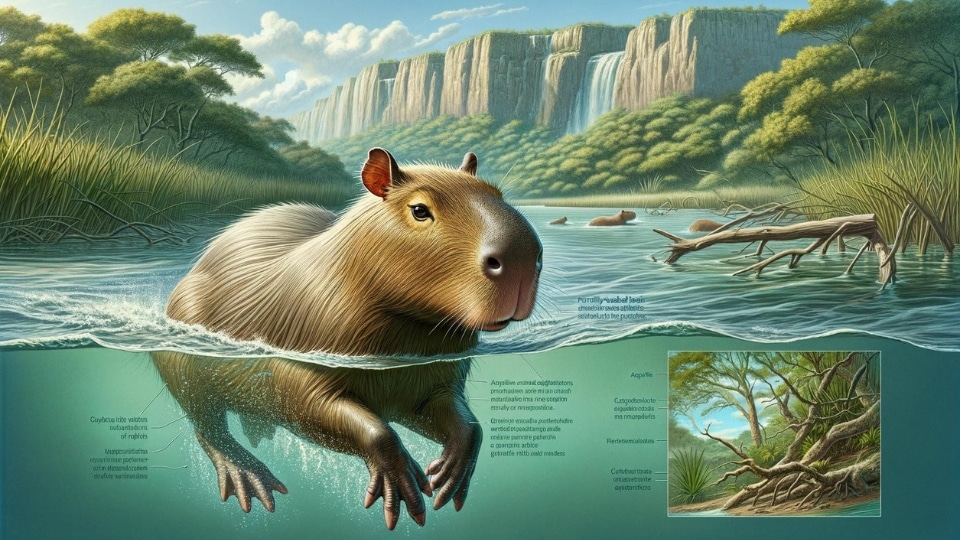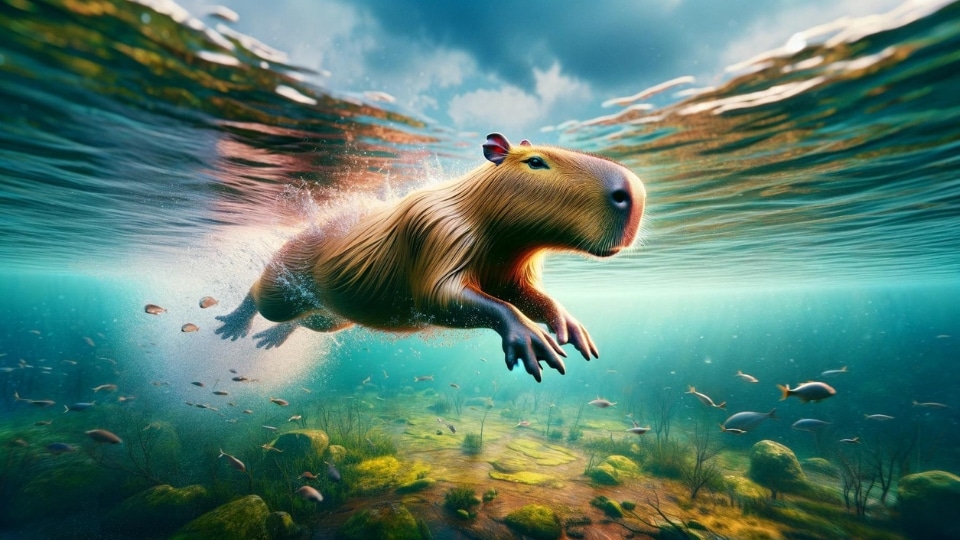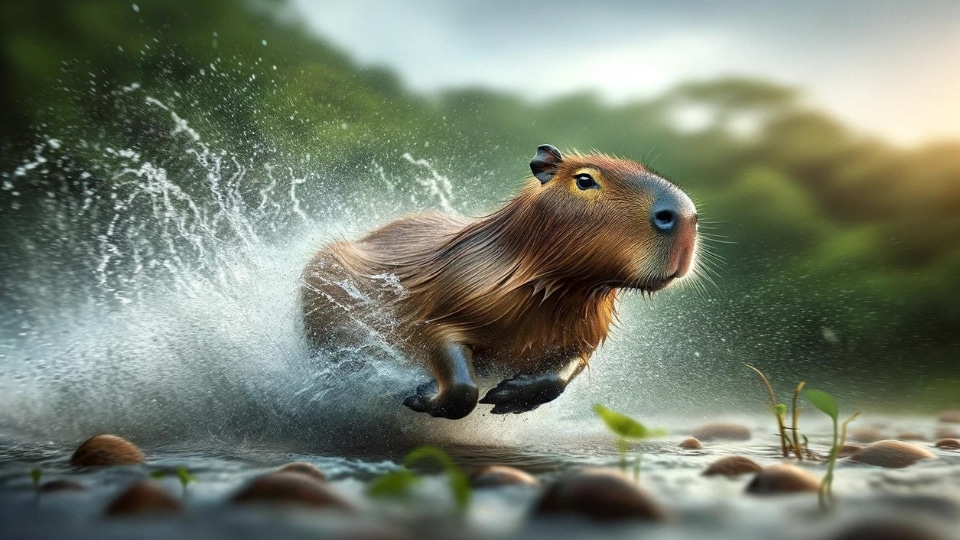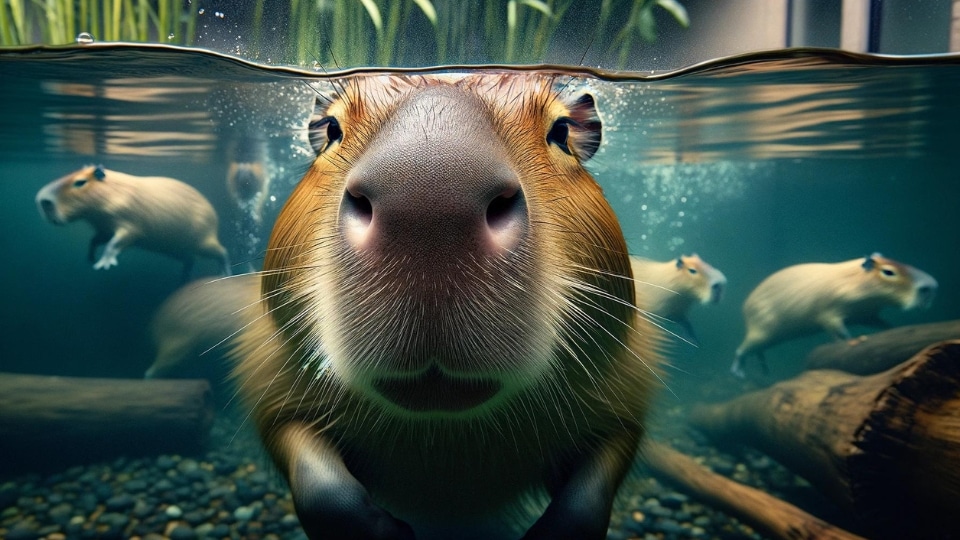Capybaras, the world’s largest rodents, are not just remarkable for their size but also for their exceptional swimming abilities. This semi-aquatic mammal is found primarily in South America’s riverbanks, marshes, and ponds. Swimming is not just a pastime for these creatures; it’s an essential part of their survival, offering both a means of escape from predators and a way to keep their skin healthy.
In the heart of South America, villagers often recount tales of capybaras gracefully swimming alongside canoes, a testament to their peaceful coexistence with humans.
The Aquatic Adaptations of Capybaras

Capybaras are superbly adapted to life in and around water. Their partially webbed feet facilitate efficient swimming, allowing them to maneuver through water with ease. Remarkably, they can stay submerged for up to five minutes – a skill they often use to evade predators. Just like hippos, capybaras have their eyes, ears, and nostrils located high on their heads, enabling them to see, hear, and breathe while keeping most of their body underwater.
In their natural habitat, capybaras are often found near standing water. They rely on water bodies not only for protection but also for regulating their body temperature and maintaining their skin’s health. Without regular access to water, their skin can dry out. Additionally, these water-loving rodents feed on various water plants, showcasing their dependence on aquatic ecosystems for nutrition.
While discussing the typical appearance of capybaras, it’s interesting to note that rare variations, like albino capybaras, exist, showcasing the remarkable diversity within the species.
Capybaras exhibit unique social behaviors in their aquatic environments. They are social animals, usually seen in groups, and these gatherings are often around water sources. Their swimming skills are evident from a young age, with capybara pups venturing into water shortly after birth.
Did you know that capybaras exhibit a unique social behavior in water? They often swim in groups, which is a part of their social structure. This group swimming is not just for safety, but also for establishing social bonds within the group.
The Swimming Capabilities of Capybaras

Capybaras are natural swimmers, a trait they share with beavers. With partially webbed feet and a streamlined body, they glide through water with ease. These semi-aquatic mammals are often found in the water bodies of South America, their native habitat.
Swimming serves multiple purposes for capybaras. Primarily, it’s a way to escape from predators like jaguars and anacondas. But it’s also a method for regulating their body temperature in the hot climate and a social activity among groups. Dive deeper into their aquatic skills and other fascinating traits.
Speed and Agility in Water

While capybaras are not known for rapid swimming, they can reach speeds of up to 8 km/h (5 miles per hour) when necessary, especially when evading predators. On average, their swimming speed is slower, but their body is well-adapted for swift movement in water. This is slightly faster than the average kayak paddling speed, which is around 2-3 miles per hour which perhaps contributes to certain cultural beliefs, such as viewing them as fish during the Lenten period.
While capybaras are skilled swimmers, their ability to move swiftly on land is also noteworthy, with their running speed being a key aspect of their survival tactics.
Breathing Techniques and Underwater Capabilities

Capybaras are capable of staying underwater for up to five minutes to evade predators. They can’t breathe underwater, but due to the position of their nostrils at the tip of their heads, they can keep most of their bodies submerged while breathing. This technique is also used when they sleep in water, allowing them to stay mostly submerged for protection while keeping their nostrils above the surface. Capybaras are excellent swimmers, but if you’re considering one as a pet in California, make sure to understand the state’s legal stance.
Did you know? Capybaras are attracted to warm water? A viral video of capybaras in hot springs highlighted this preference. Although they don’t naturally seek hot springs, they do enjoy and are more relaxed in warm water, similar to their native habitat’s climate.
Comparative Analysis
Based on new information, the comparison table between capybara swimming and other rodents is updated:
| Feature | Capybara | Beaver | Muskrat |
|---|---|---|---|
| Average Size | Up to 134 cm | Up to 100 cm | Up to 50 cm |
| Swimming Speed | Up to 8 km/h | 6-8 km/h | 5-8 km/h |
| Dive Duration | Up to 5 mins | 15 mins | 15-20 mins |
| Social Swimming | Yes | No | Occasionally |
| Underwater Foraging | Yes | Yes | Yes |
Conclusion
The capybara’s unique adaptations and social behaviors in water not only demonstrate their special place in the aquatic world but also continue to fascinate us. Have you ever encountered these amazing creatures or know more interesting facts about them? Share your experiences and thoughts in the comments below, and join us in our journey of exploring the wonders of wildlife.



